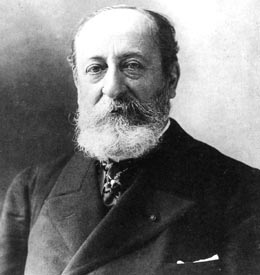Information
Composer: Camille Saint-Saëns
- Violin Concerto No. 1 in A major, Op. 20: Allegro -
- Violin Concerto No. 1 in A major, Op. 20: Andante espressivo -
- Violin Concerto No. 1 in A major, Op. 20: (Reprise)
- Violin Concerto No. 2 in C major, Op. 58: I. Allegro moderato e maestoso
- Violin Concerto No. 2 in C major, Op. 58: II. Andante espressivo
- Violin Concerto No. 2 in C major, Op. 58: III. Allegro scherzando quasi allegretto
- Violin Concerto No. 3 in B minor, Op. 61: I. Allegro non troppo
- Violin Concerto No. 3 in B minor, Op. 61: II. Andantino quasi allegretto
- Violin Concerto No. 3 in B minor, Op. 61: III. Molto moderato e maestoso - Allegro non troppo
Philippe Graffin, violin
BBC Scottish Symphony Orchestra
Martyn Brabbins, conductor
Date: 1998
Label: Hyperion
http://www.hyperion-records.co.uk/dc.asp?dc=D_CDA67074
-------------------------------------------------------------------
Review
Hyperion could hardly have launched its Romantic Violin Concerto series with a happier programme. Like Beethoven’s and Chopin’s First and Second Piano Concertos, the first two violin concertos of Saint-Saens were composed in reverse order. The Second is the longer and lesser-known of the two (though Ivry Gitlis made a stunning record of it for Philips in the late 1960s), but the First Concerto more resembles the thematic charm and concise design of the First Cello Concerto. Cast in a single short movement that falls into three distinct sections, it launches the soloist on his way right from the start (six emphatic chords) and features a delightful central section with some felicitous woodwind writing. Hyperion holds a trump card in Philippe Graffin, whose elegant, emotionally charged playing is strongly reminiscent of the young Menuhin (he has a similar sort of sound) and whose understanding of the idiom seems to me second to none – certainly among modern players.
Saint-Saens’s First Violin Concerto was composed in 1859, whereas his Second preceded it by a year. Unexpectedly, the first movement’s thematic material has an almost Weberian slant. The orchestration is heavier than in the First (trombones in the second movement are reminiscent of Berlioz), and the musical arguments are both more formal and more forcefully stated. It is a more overtly virtuoso work than the First Concerto, and to my mind rather less memorable, but again Graffin weaves a winsome solo line and Martyn Brabbins directs a strong account of the orchestral score, with prominently projected woodwinds.
The relatively well-known Third Concerto (1880) is roughly the same length as the Second (around half-an-hour), but is more consistently interesting. The basic material is of higher quality, the key relations more telling and orchestration infinitely more delicate. I can honestly say that I have never heard a recording that liberates so much of the score’s instrumental detail, probably because most of Graffin’s predecessors have invariably been balanced way in front of the orchestra. The closing moments of the slow movement, where violin harmonics are doubled by a clarinet, are pure magic.
As to comparisons, a handful of good Firsts are currently available, though none ‘speaks’ quite so beguilingly as Graffin does here. I would personally court alternatives only in the Third: Milstein’s aristocratic reading with the Philharmonia is in a class of its own, and so is Aaron Rosand’s full-blooded version for Vox. Neither is currently listed but Graffin compares favourably with both (his is a gentler, more introverted view of the score) and is of course far better recorded. This is the only domestically released CD that includes all three concertos on a single disc.
Incidentally, there is also an ‘uncompleted’ Fourth Concerto (1880) known as Morceau de concert which Gitlis coupled with his version of the Second Concerto (it’s out on the Continent on Philips (CD) 446 188-2, just in case you fancy browsing the internet) and which Hyperion might profitably programme alongside other shorter Saint-Saens works for violin and orchestra.
Altogether an excellent production and an auspicious start to a series which, like its piano predecessor, seems set to bring a wealth of musical delights to our attention. DD provides excellent annotation and I can hardly wait for the next instalment.
-- Gramophone
More reviews:
-------------------------------------------------------------------
Camille Saint-Saëns (9 October 1835 – 16 December 1921) was a French composer, organist, conductor and pianist of the Romantic era. His best-known works include his concertos for violin, piano and cello, his 3rd symphony, Danse macabre and The Carnival of the Animals. Saint-Saëns was a musical prodigy, making his concert debut at the age of ten. He held only one teaching post for less than five years. His students included Gabriel Fauré.
http://en.wikipedia.org/wiki/Camille_Saint-Sa%C3%ABns
http://en.wikipedia.org/wiki/Camille_Saint-Sa%C3%ABns
***
Philippe Graffin (born 1964 in Romilly-sur-Seine, France) is a French violinist. Graffin was a student of the late Joseph Gingold and Philippe Hirschhorn. He has made numerous landmark recordings for labels such as Hyperion, Avie, ASV and Onyx. Graffin plays a Domenico Busano violin, made in Venice, 1730. He is currently professor at the Paris Conservatoire National Supérieur de Musique and guest professor at the Brussels Conservatoire Royal.
http://en.wikipedia.org/wiki/Philippe_Graffin
http://en.wikipedia.org/wiki/Philippe_Graffin
-------------------------------------------------------------------
FLAC, tracks
Links in comment
Enjoy!



This comment has been removed by the author.
ReplyDeleteBroken link. Please repost.
ReplyDeleteChoose one link, copy and paste it to your browser's address bar, wait a few seconds (you may need to click 'Continue' first), then click 'Skip Ad' (or 'Get link').
ReplyDeleteIf you are asked to download or install anything, IGNORE, only download from file hosting site (mega.nz).
If MEGA shows 'Bandwidth Limit Exceeded' message, try to create a free account.
http://vismuene.com/CQY
or
http://uii.io/PAfN
or
http://exe.io/WkTx9GNT